Influence of Hole Localization on Local and Global Dynamic Response of Thin-Walled Laminated Cantilever Beam
Abstract
1. Introduction
2. Object of the Study
3. Finite Element Method (FEM)
4. Experimental Modal Analysis
5. Results and Discussion
6. Conclusions
Author Contributions
Funding
Institutional Review Board Statement
Informed Consent Statement
Data Availability Statement
Conflicts of Interest
References
- Jackson, M.; Shukla, A. Performance of sandwich composites subjected to sequential impact and air blast loading. Compos. Part B Eng. 2011, 42, 155–166. [Google Scholar] [CrossRef]
- Yang, X.; Swamidas, A.; Seshadri, R. Crack identification in vibrating beams using the energy method. J. Sound Vib. 2001, 244, 339–357. [Google Scholar] [CrossRef]
- Ashory, M.-R.; Ghasemi-Ghalebahman, A.; Kokabi, M.-J. An efficient modal strain energy-based damage detection for laminated composite plates. Adv. Compos. Mater. 2017, 27, 147–162. [Google Scholar] [CrossRef]
- Wronkowicz-Katunin, A.; Dragan, K. Evaluation of Impact Damage in Composite Structures Using Ultrasonic Testing. Fatigue Aircr. Struct. 2018, 2018, 82–92. [Google Scholar] [CrossRef]
- Ding, G.; Song, W.; Gao, X.; Cao, H. Damage Detection in Holed Carbon Fiber Composite Laminates Using Embedded Fiber Bragg Grating Sensors Based on Strain Information. Shock. Vib. 2020, 2020, e8813213. [Google Scholar] [CrossRef]
- Stawiarski, A.; Miarka, S.; Barski, M.; Romanowicz, P. Fatigue Damage Detection in Composite Plate with a Circular Hole by Elastic Wave Propagation Method. Compos. Theory Pract. 2016, 16, 20–24. [Google Scholar]
- Gerges, S.; Sultan, R.; Younes, M.; Soaly, E. Delamination Identification on Composite Material by Free Vibration Test. Int. J. Mech. Eng. Robot. Res. 2012, 1, 227–236. [Google Scholar]
- Kisa, M. Free vibration analysis of a cantilever composite beam with multiple cracks. Compos. Sci. Technol. 2004, 64, 1391–1402. [Google Scholar] [CrossRef]
- Lestari, W.; Hanagud, S. Health Monitoring of Structures—Multiple Delamination Dynamics in Composite Beams. In Structures, Structural Dynamics, and Materials and Co-Located Conferences, Proceedings of the 40th Structures, Structural Dynamics, and Materials Conference and Exhibit, St. Louis, MO, USA, 12–15 April 1999; American Institute of Aeronautics and Astronautics: Reston, VA, USA, 1999. [Google Scholar]
- Manoach, E.; Warminski, J.; Kloda, L.; Teter, A. Numerical and experimental studies on vibration based methods for detection of damage in composite beams. Compos. Struct. 2017, 170, 26–39. [Google Scholar] [CrossRef]
- Kessler, S.S.; Spearing, S.; Atalla, M.J.; Cesnik, C.E.; Soutis, C. Damage detection in composite materials using frequency response methods. Compos. Part B Eng. 2002, 33, 87–95. [Google Scholar] [CrossRef]
- Govindasamy, M.; Kamalakannan, G.; Kesavan, C.; Meenashisundaram, G.K. Damage Detection in Glass/Epoxy Laminated Composite Plates Using Modal Curvature for Structural Health Monitoring Applications. J. Compos. Sci. 2020, 4, 185. [Google Scholar] [CrossRef]
- Manson, G.; Worden, K.; Monnier, T.; Guy, P.; Pierce, S.; Culshaw, B. Some Experimental Observations on the Detection of Composite Damage using Lamb Waves. Strain 2009, 47, e254–e268. [Google Scholar] [CrossRef]
- Scalerandi, M.; Gliozzi, A.; Bruno, C.L.E.; Masera, D.; Bocca, P. A scaling method to enhance detection of a nonlinear elastic response. Appl. Phys. Lett. 2008, 92, 101912. [Google Scholar] [CrossRef]
- Gürgen, S.; Sofuoğlu, M.A. Vibration attenuation of sandwich structures filled with shear thickening fluids. Compos. Part B Eng. 2020, 186, 107831. [Google Scholar] [CrossRef]
- Gürgen, S.; Sofuoğlu, M.A. Smart polymer integrated cork composites for enhanced vibration damping properties. Compos. Struct. 2020, 258, 113200. [Google Scholar] [CrossRef]
- Rehfield, L.W.; Atilgan, A.R.; Hodges, D.H. Nonclassical Behavior of Thin-Walled Composite Beams with Closed Cross Sections. J. Am. Helicopter Soc. 1990, 35, 42–50. [Google Scholar] [CrossRef]
- Latalski, J.; Bochenski, M.; Warminski, J. Control of Bending-Bending Coupled Vibrations of a Rotating Thin-Walled Composite Beam. Arch. Acoust. 2015, 39, 605–613. [Google Scholar] [CrossRef][Green Version]
- Teter, A.; Gawryluk, J. Experimental modal analysis of a rotor with active composite blades. Compos. Struct. 2016, 153, 451–467. [Google Scholar] [CrossRef]
- Abaqus 6.14 HTML Documentation. Available online: http://130.149.89.49:2080/v6.14/ (accessed on 10 October 2021).
- Teter, A.; Gawryluk, J.; Bocheński, M. Experimental and numerical studies of a cracked thin-walled box-beams. Compos. Struct. 2018, 202, 807–817. [Google Scholar] [CrossRef]
- Gawryluk, J.; Bocheński, M.; Teter, A. Modal Analysis of Laminated “CAS” and “CUS” Box-Beams. Arch. Mech. Eng. 2017, 64, 441–454. [Google Scholar] [CrossRef]
- Barbero, E.J. Finite Element Analysis of Composite Materials Using AbaqusTM; CRC Press: Boca Raton, FL, USA, 2015; ISBN 978-0-429-09666-2. [Google Scholar]
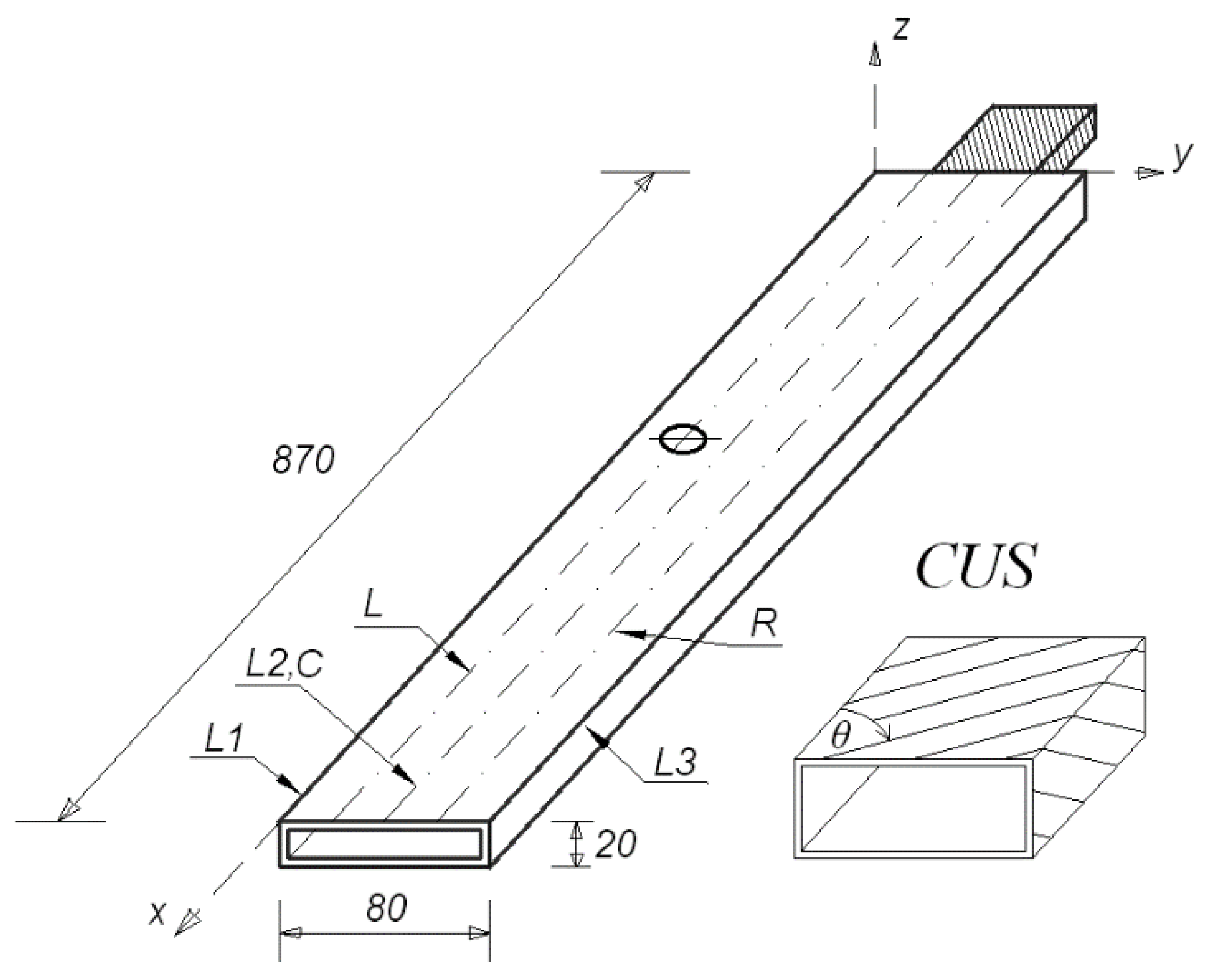

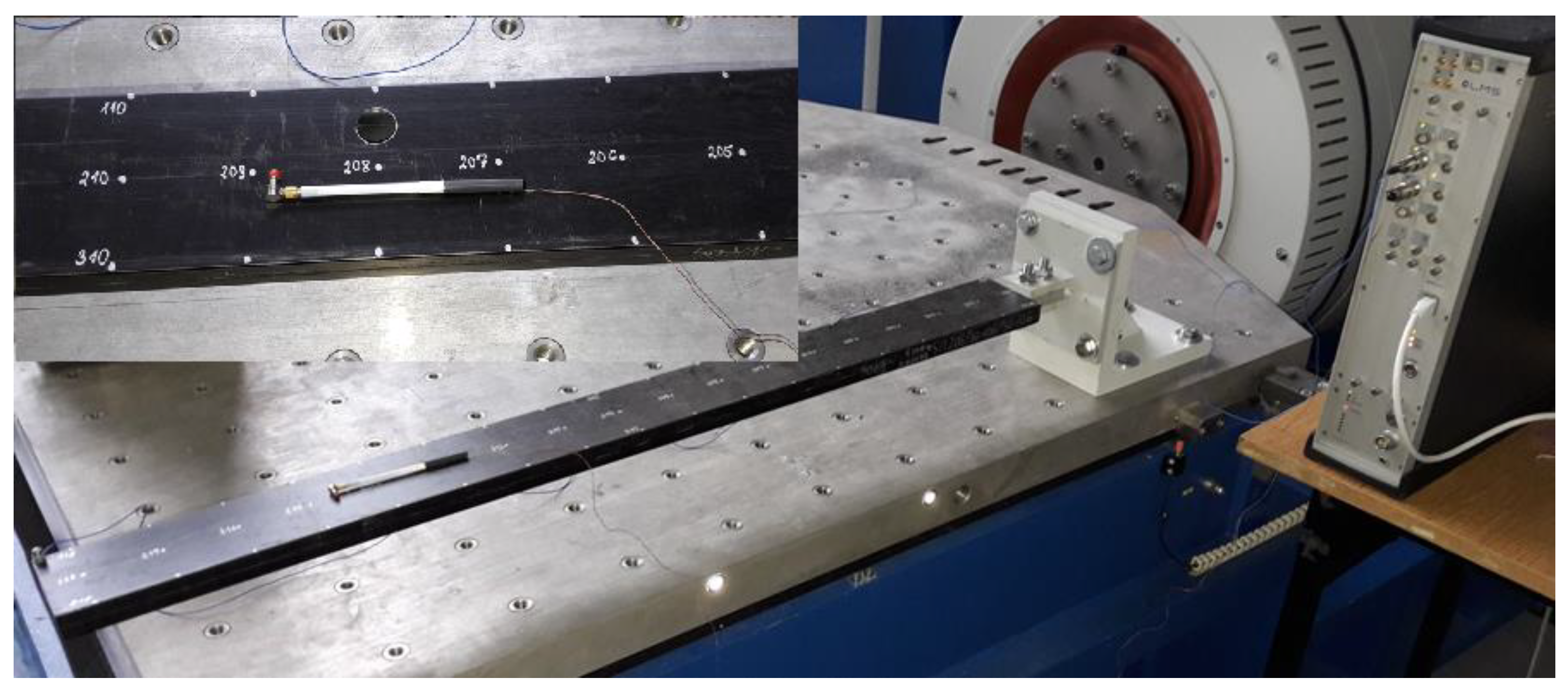
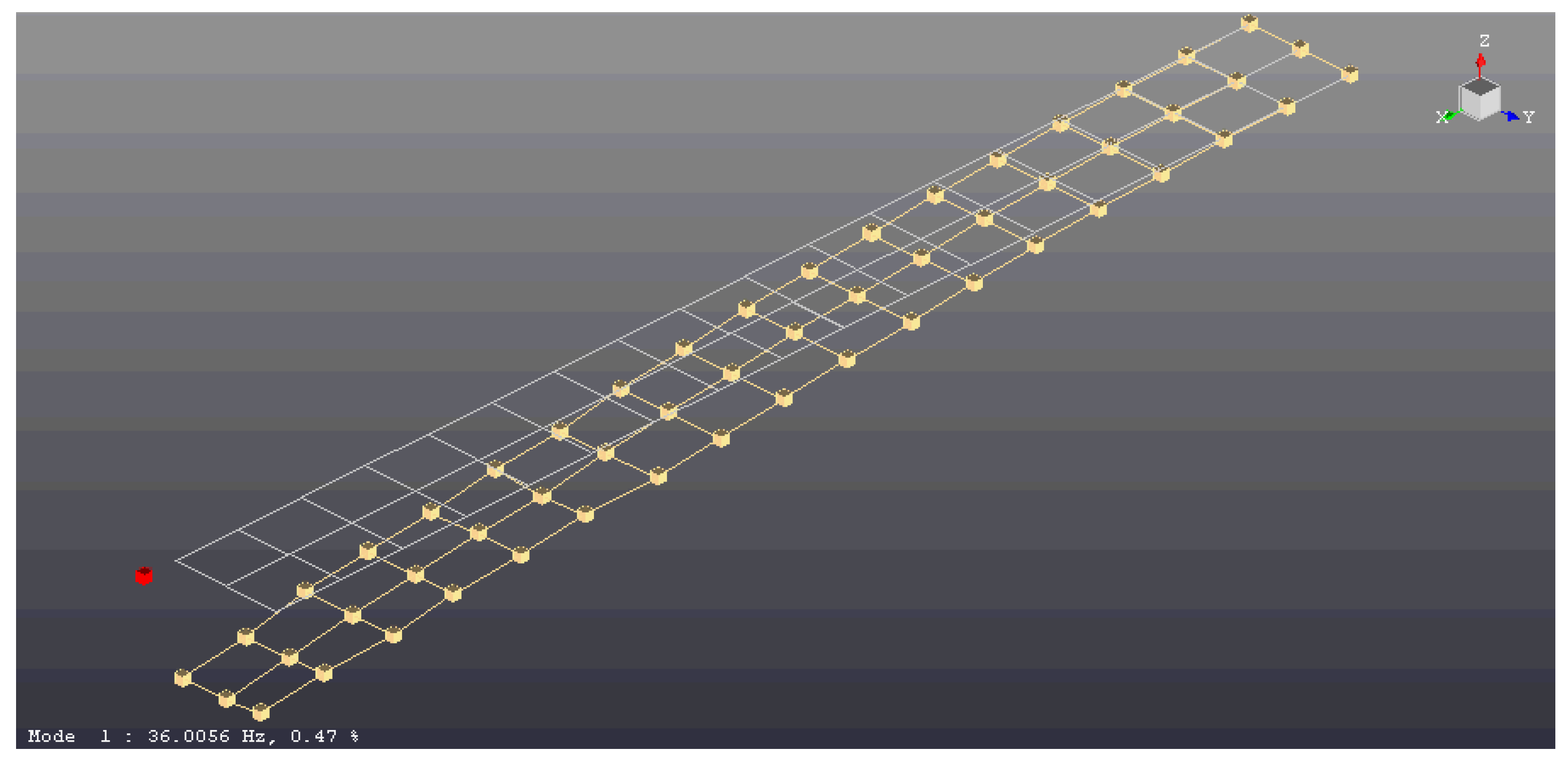
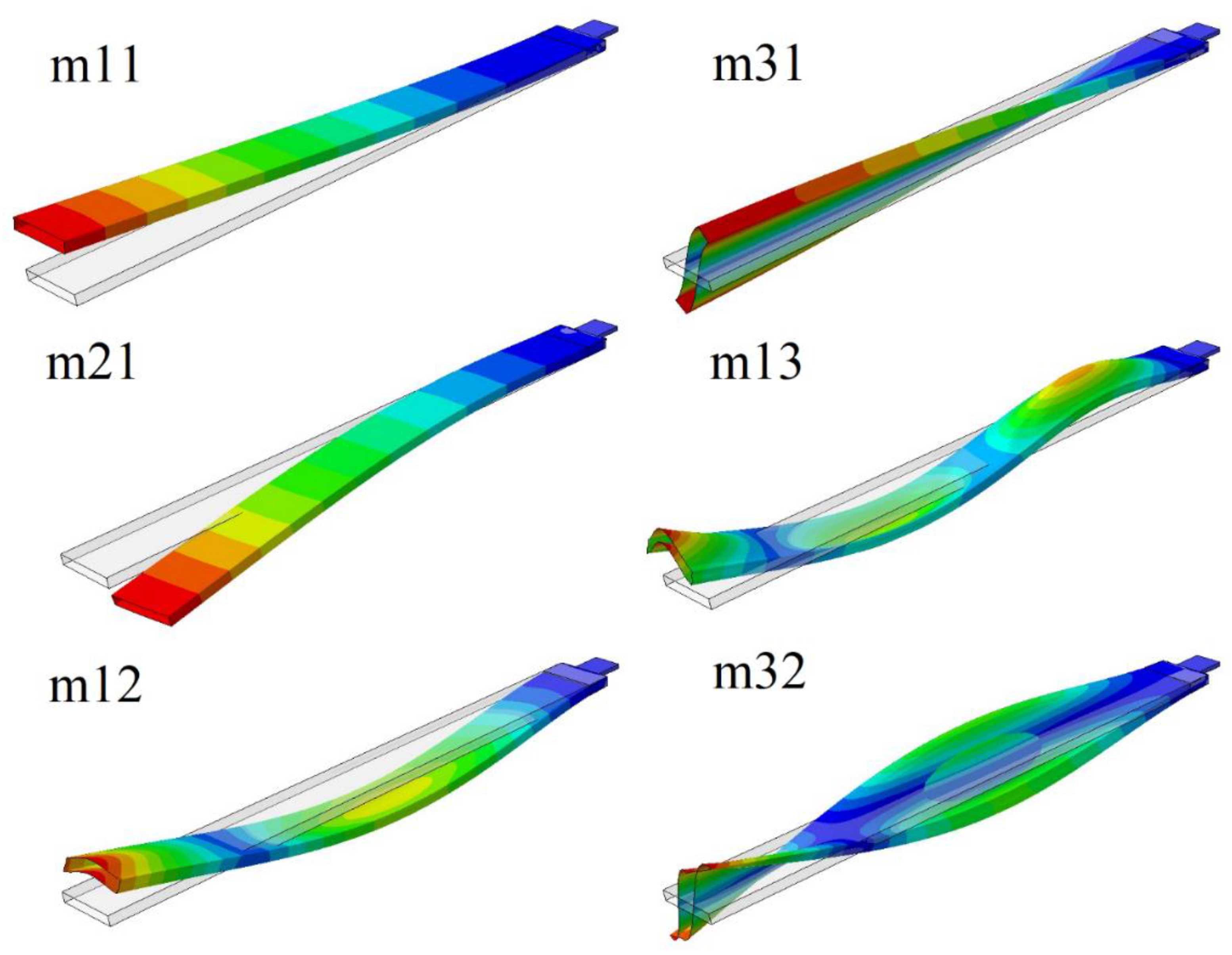

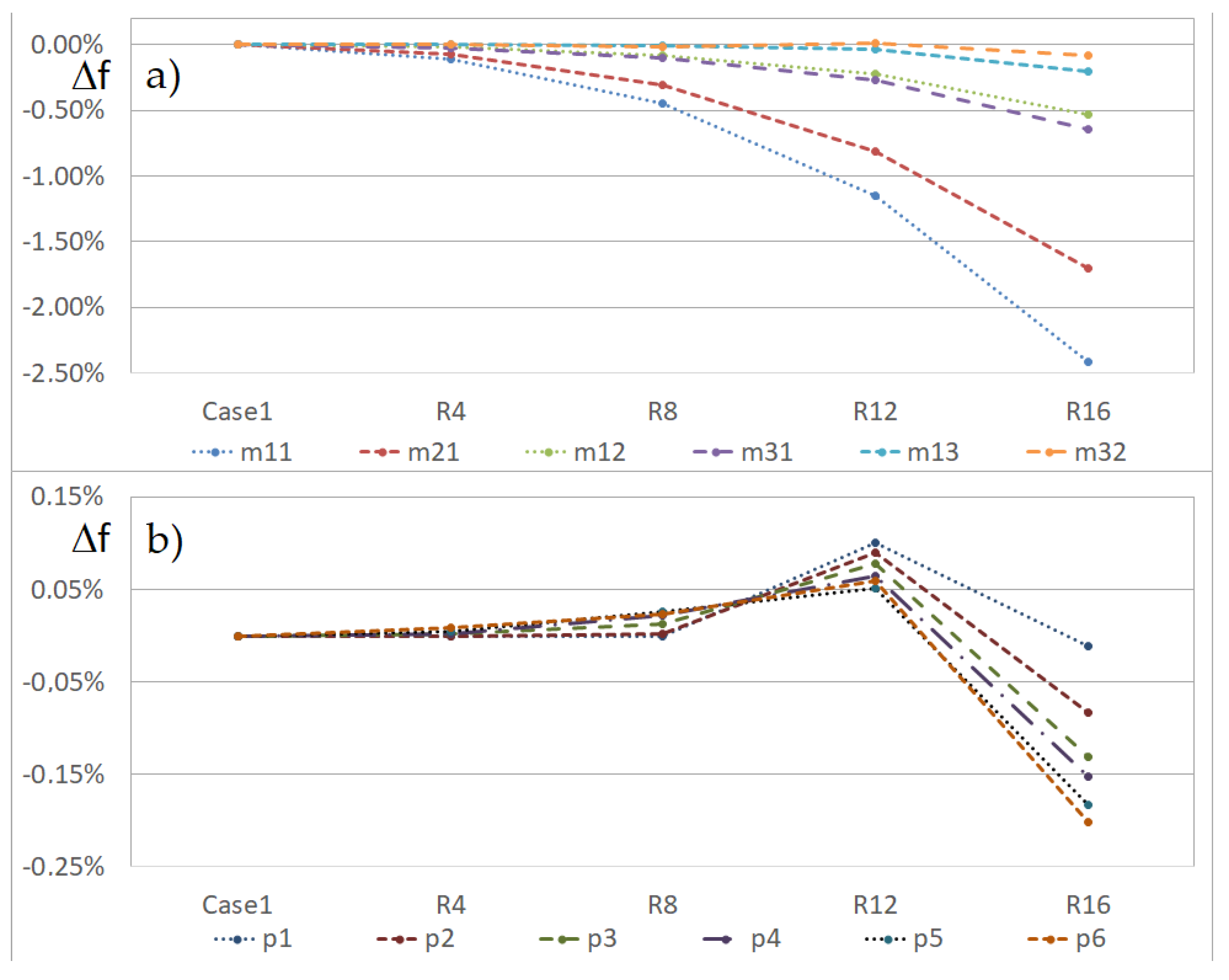
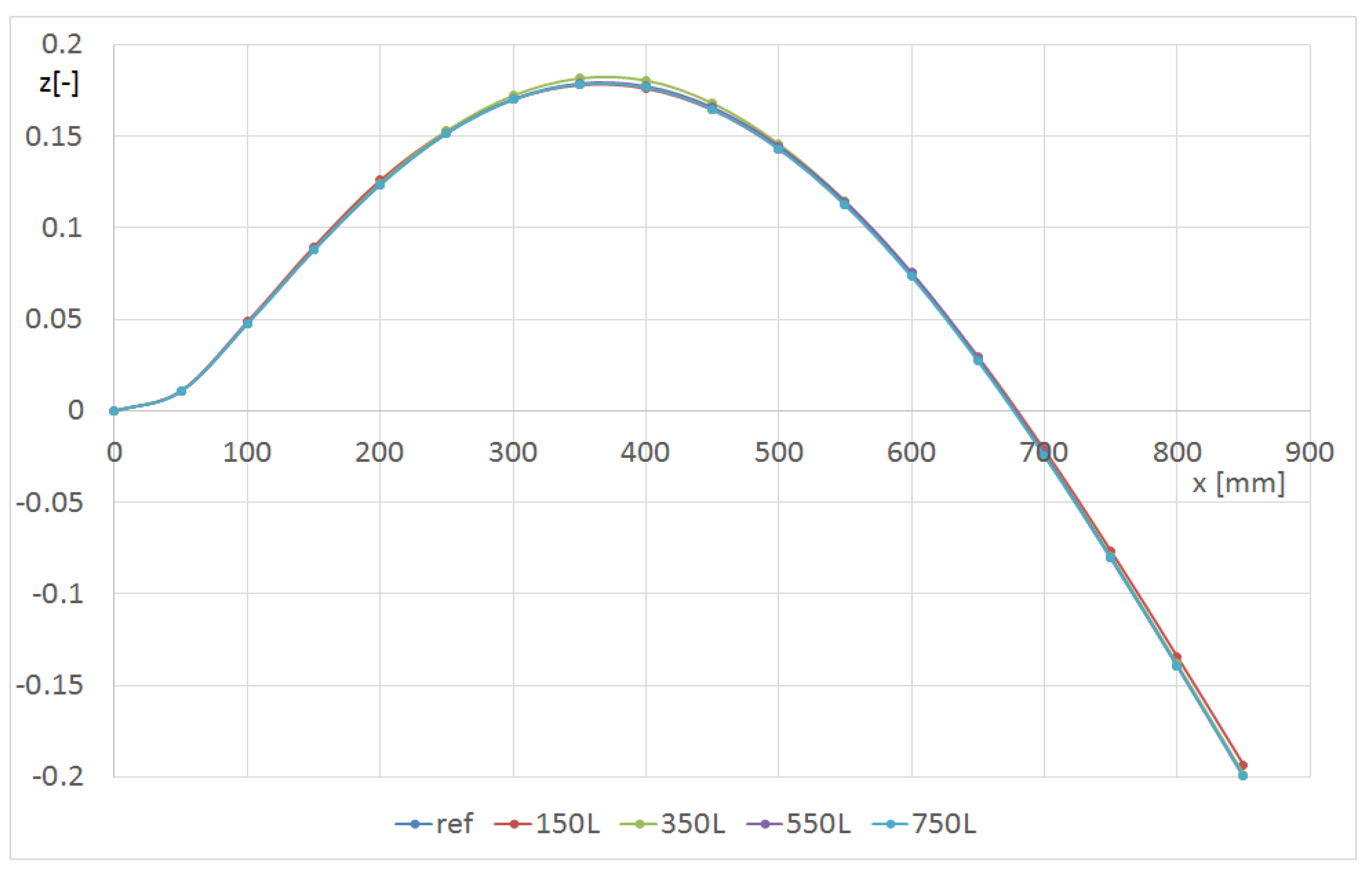
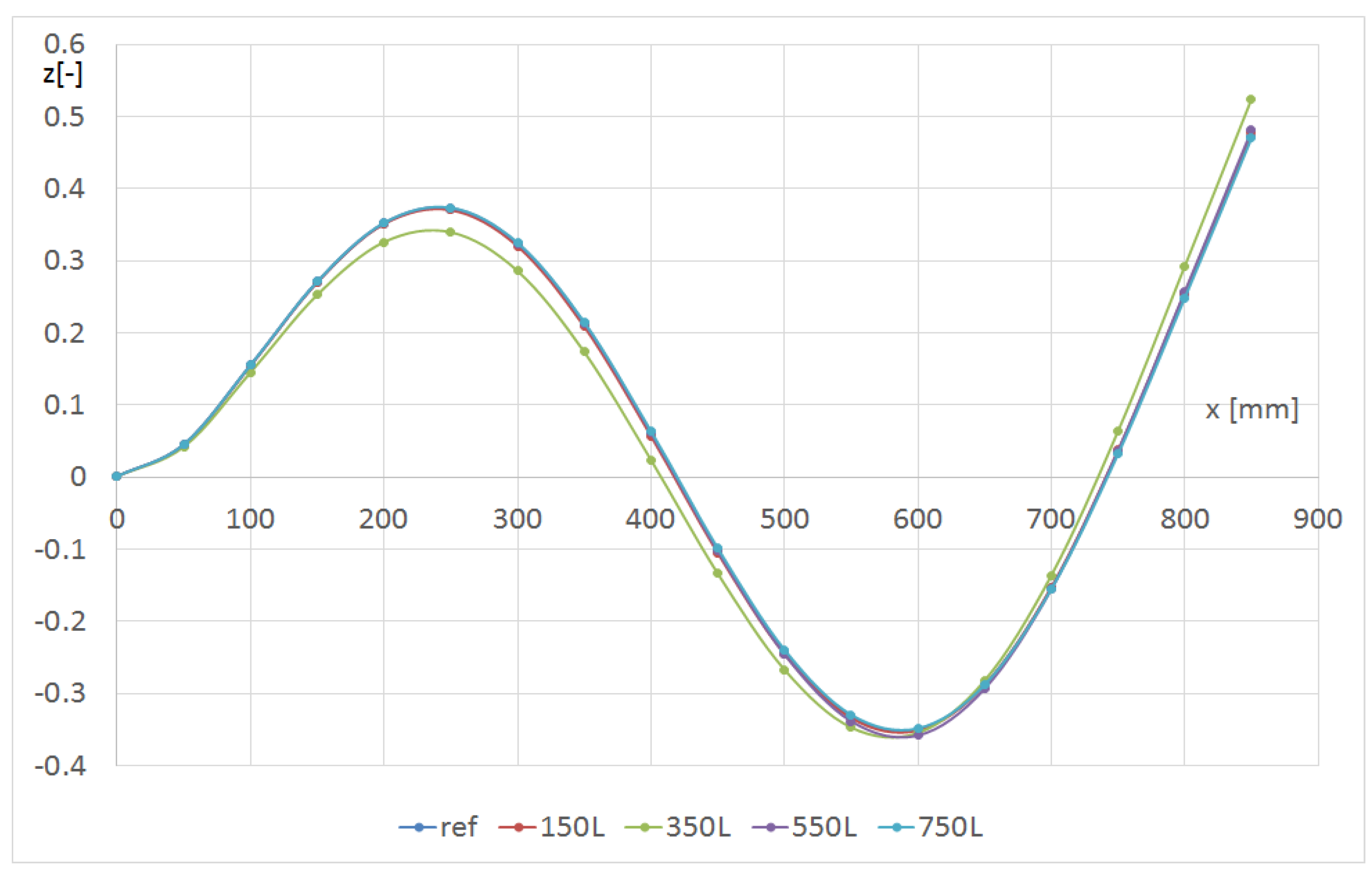
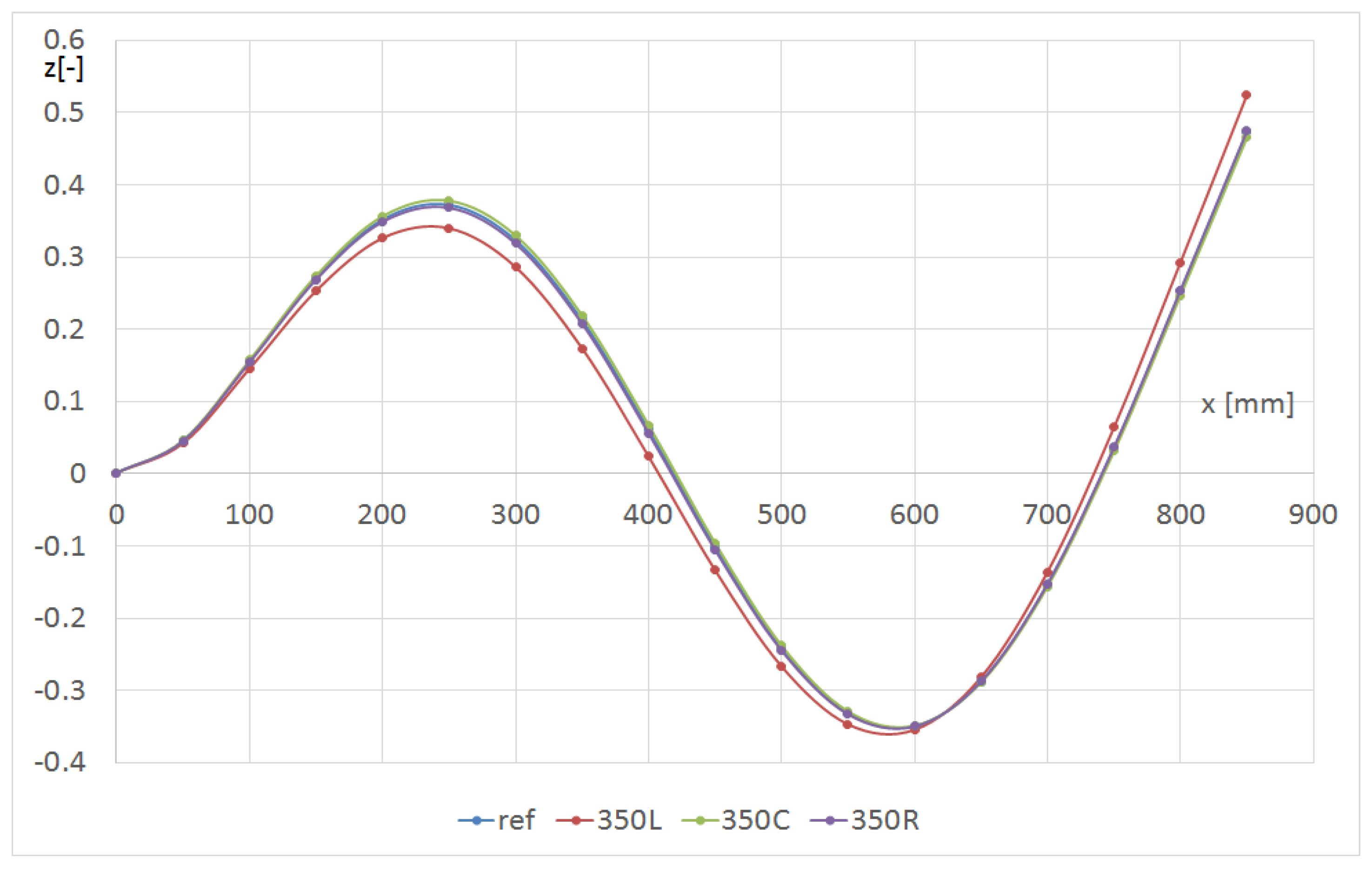

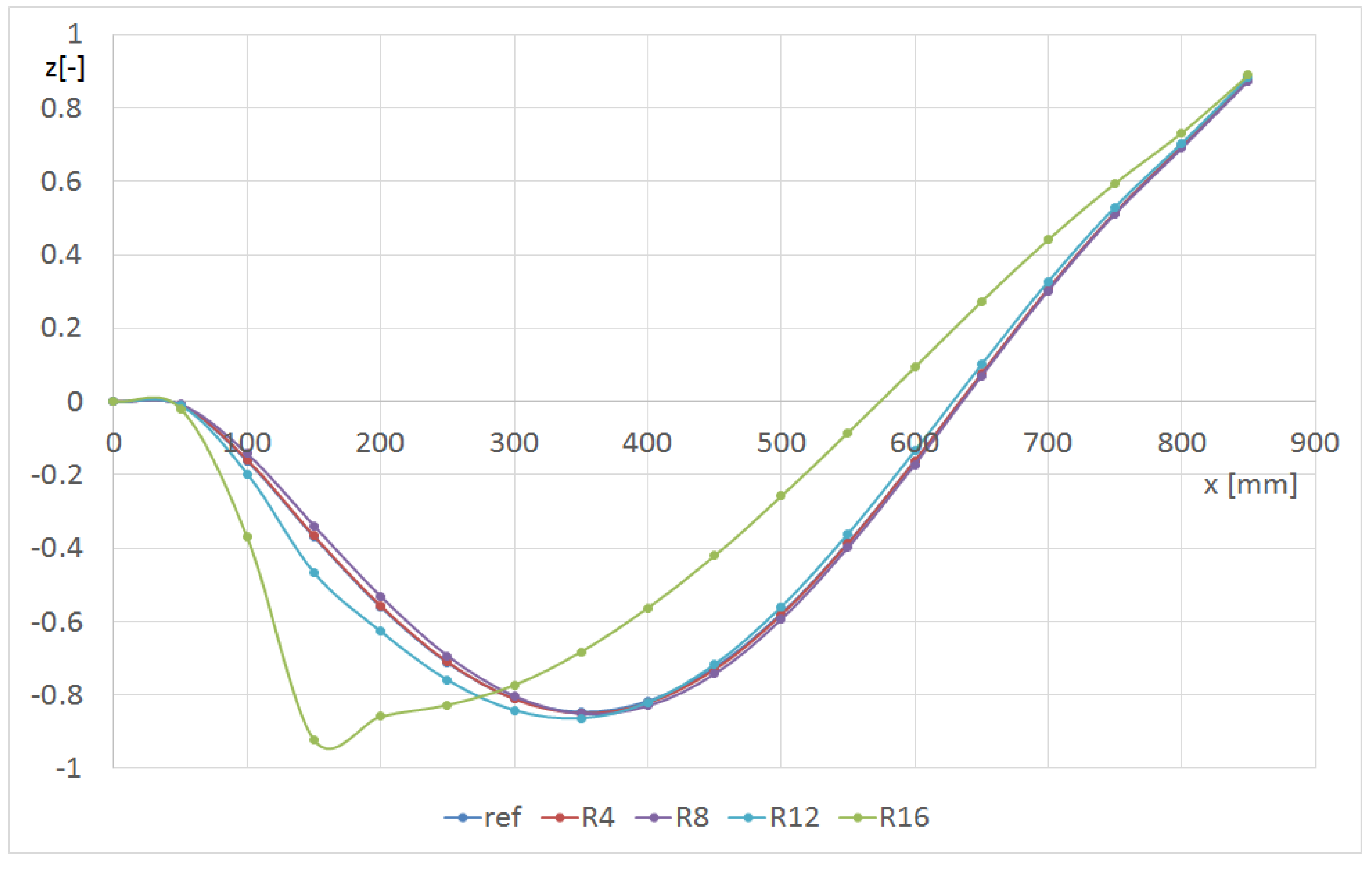
| FEM | Experimental Results | |||||
|---|---|---|---|---|---|---|
| Modes | Case1 | Case2 | δ | Case1 | Case2 | δ |
| m11 | 33.601 | 33.540 | −0.18% | 35.996 | 35.821 | −0.48% |
| m21 | 97.626 | 97.499 | −0.13% | 101.899 | 101.729 | −0.17% |
| m12 | 194.230 | 194.120 | −0.06% | 190.606 | 190.275 | −0.17% |
| m31 | 221.640 | 221.420 | −0.10% | 202.646 | 202.182 | −0.23% |
| m13 | 359.680 | 359.810 | 0.04% | 316.586 | 317.224 | 0.20% |
| m32 | 363.700 | 363.310 | −0.11% | 294.965 | 296.373 | 0.48% |
| Distance from the Fixed Grip | |||||||||||||
|---|---|---|---|---|---|---|---|---|---|---|---|---|---|
| 150 mm | 350 mm | 550 mm | 750 mm | ||||||||||
| Case1 | Case2 | Case2 | Case2 | Case2 | |||||||||
| Modes | - | L | C | R | L | C | R | L | C | R | L | C | R |
| 1 (m11) | 33.60 | 33.45 | 33.43 | 33.41 | 33.54 | 33.54 | 33.53 | 33.61 | 33.61 | 33.60 | 33.65 | 33.65 | 33.65 |
| 2 (m21) | 97.63 | 97.32 | 97.61 | 97.35 | 97.50 | 97.65 | 97.59 | 97.64 | 97.69 | 97.67 | 97.76 | 97.77 | 97.76 |
| 3 (m12) | 194.23 | 194.07 | 194.19 | 194.16 | 194.12 | 193.98 | 193.77 | 193.97 | 193.82 | 193.57 | 194.26 | 194.23 | 194.21 |
| 4 (m31) | 221.64 | 221.41 | 221.36 | 221.32 | 221.42 | 221.39 | 221.43 | 221.52 | 221.49 | 221.54 | 221.59 | 221.57 | 221.60 |
| 5 (m13) | 359.68 | 359.64 | 359.69 | 359.84 | 359.81 | 359.67 | 359.40 | 359.02 | 359.47 | 359.73 | 359.62 | 359.45 | 359.42 |
| 6 (m32) | 363.70 | 363.65 | 363.47 | 363.55 | 363.31 | 363.48 | 363.35 | 363.49 | 363.47 | 363.33 | 363.48 | 363.46 | 363.38 |
| 7 (p1) | 455.82 | 455.82 | 455.43 | 455.82 | 455.84 | 455.37 | 455.84 | 455.89 | 455.28 | 455.90 | 455.97 | 455.15 | 456.00 |
| 8 (p2) | 456.64 | 456.65 | 456.20 | 456.67 | 456.75 | 456.00 | 456.76 | 456.68 | 456.20 | 456.67 | 456.70 | 456.18 | 456.72 |
| 9 (p3) | 458.42 | 458.48 | 457.90 | 458.50 | 458.44 | 458.00 | 458.43 | 458.58 | 457.79 | 458.62 | 458.42 | 458.03 | 458.42 |
| 10 (p4) | 461.32 | 461.42 | 460.70 | 461.44 | 461.33 | 460.85 | 461.37 | 461.31 | 460.93 | 461.33 | 461.34 | 460.91 | 461.32 |
| 11 (p5) | 465.77 | 465.89 | 465.08 | 465.90 | 465.86 | 465.10 | 465.83 | 465.91 | 465.14 | 465.90 | 465.87 | 465.22 | 465.84 |
| 12 (p6) | 472.08 | 472.19 | 471.41 | 472.15 | 472.05 | 471.72 | 472.02 | 472.11 | 471.56 | 472.22 | 472.24 | 471.39 | 472.25 |
| Radius of the Hole | |||||
|---|---|---|---|---|---|
| Modes | Case1 | R4 | R8 | R12 | R16 |
| 1 (m11) | 33.601 | 33.565 | 33.450 | 33.214 | 32.791 |
| 2 (m21) | 97.626 | 97.554 | 97.322 | 96.832 | 95.968 |
| 3 (m12) | 194.230 | 194.190 | 194.070 | 193.800 | 193.190 |
| 4 (m31) | 221.640 | 221.580 | 221.410 | 221.040 | 220.210 |
| 5 (m13) | 359.680 | 359.670 | 359.640 | 359.550 | 358.930 |
| 6 (m32) | 363.700 | 363.690 | 363.650 | 363.730 | 363.390 |
| 7 (p1) | 455.820 | 455.820 | 455.820 | 456.280 | 455.770 |
| 8 (p2) | 456.640 | 456.640 | 456.650 | 457.050 | 456.260 |
| 9 (p3) | 458.420 | 458.430 | 458.480 | 458.780 | 457.820 |
| 10 (p4) | 461.320 | 461.330 | 461.420 | 461.620 | 460.620 |
| 11 (p5) | 465.770 | 465.790 | 465.890 | 466.010 | 464.920 |
| 12 (p6) | 472.080 | 472.120 | 472.190 | 472.360 | 471.130 |
Publisher’s Note: MDPI stays neutral with regard to jurisdictional claims in published maps and institutional affiliations. |
© 2021 by the authors. Licensee MDPI, Basel, Switzerland. This article is an open access article distributed under the terms and conditions of the Creative Commons Attribution (CC BY) license (https://creativecommons.org/licenses/by/4.0/).
Share and Cite
Bochenski, M.; Gawryluk, J.; Teter, A. Influence of Hole Localization on Local and Global Dynamic Response of Thin-Walled Laminated Cantilever Beam. Materials 2021, 14, 7409. https://doi.org/10.3390/ma14237409
Bochenski M, Gawryluk J, Teter A. Influence of Hole Localization on Local and Global Dynamic Response of Thin-Walled Laminated Cantilever Beam. Materials. 2021; 14(23):7409. https://doi.org/10.3390/ma14237409
Chicago/Turabian StyleBochenski, Marcin, Jaroslaw Gawryluk, and Andrzej Teter. 2021. "Influence of Hole Localization on Local and Global Dynamic Response of Thin-Walled Laminated Cantilever Beam" Materials 14, no. 23: 7409. https://doi.org/10.3390/ma14237409
APA StyleBochenski, M., Gawryluk, J., & Teter, A. (2021). Influence of Hole Localization on Local and Global Dynamic Response of Thin-Walled Laminated Cantilever Beam. Materials, 14(23), 7409. https://doi.org/10.3390/ma14237409






